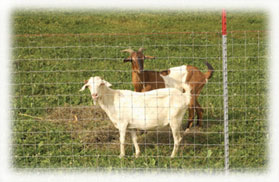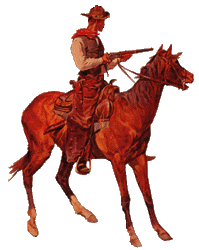
FEEDING, NUTRITION & BRUSH GOATS: **UNDER CONTRUCTION**
HERDING: This is the oldest type of goat husbandry in the world and is still practiced in many places where labor is cheap. One or more herders lead or drive the goats to the grazing areas as soon as they have been milked in the morning. They return in the evening to their enclosures are milked and stay in until morning. The herder protect the goats during the day and at night the goats are safe from maurauders, who might like a goat supper.
In Malta, where grazing is sparse, the goat herder carries the goats' midday meal of concentrates out to the pasture. Goats relate very much to people and regular routines. This system is probably ideal.
Formerly in the Scottish Highlands, from May to September the flocks were removed from arable land and taken to the summer Sheiling or shepherds hut.
(3) GOAT WORKING YARDS, HANDLING & TRANSPORT
(A) FEEDING, NUTRITION OF GOATS
(7) BUCK MANAGEMENT & ARTIFICIAL INSEMINATION
(8) GOAT GENETICS & PYGMY GOATS
GOATS ON SMALL HOLDINGS: A large part of the world's goats are owned and farmed in small units. Four or five goats can supply the needs of a family for milk, meat and skins. The goats relate to their owners on a very personal basis. The goats are usually kept in a small pen with a lounging shed and are almost entirely hand fed. In England, these goats are taken for walks daily to brouwse the hedgerows and gain much of their feed this way.
It is better to lead the goats out for half an hour in the morning and half an hour in the evening than to take them for a single two hour period. If goats are led back to their shed as soon as they start chewing their cud, they will soon learn to take as much as they can hold in one whack, and to save herding time.
Extensive Production Systems (free range on scrub and rough grazing): These systems aim primaritly to utilize whatever foodstuffs the environment makes available. It is importanto use goats which are genetically suited to this method of management. The aim is to make th most efficient use possible of the land, supplemanting the diet when necessary during the year. The stocking rate (the number of gats per unit of land) must not be allowed to become to great. The body condition of the gats should be checked regularly. Forage feeding (hay, silage or green forage) rather than concentrated feeding promotes butterfat production in the goat.
Discrimination in matters of diet is a dim instinct in goats; education on the subject is a main feature of their social life. If the social life is stunted, by lack of communal activity and separation of mother and kid, not only are the members of the herd particularly liable to poisoning, but they have a jittery approach to all food, wholesome or not. The only aid the goat farmer can lend to the natural discrimination of the herd is to himself draw attention to, spur and destroy any poisonous weed, which evades the notice of the foraging goat herd.
---See Natural Goat Care---
The goat is by its nature the symbol and mascot of subsistance agriculture. It is first and formost a household provider, and in this role its useful characteristics find their fullest expression. Domestic needs of meat and milk can be met by the goat. A crossbreed doe that yields 3 to 4 pints of milk per day and 2 to 3 kids per year with minimal concentrates may be a subsitance farmers salvation.

|
Woody Guthrie said: "So long, it's been good to know you."
(A) FEEDING, NUTRITION OF GOATS
